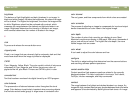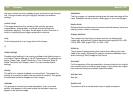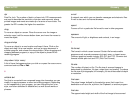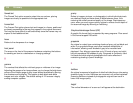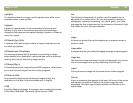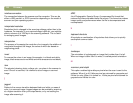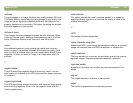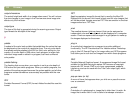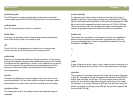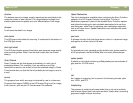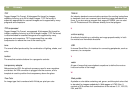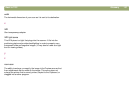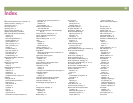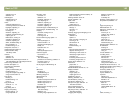
Back to TOC Glossary 133
positioning plate
This XPA piece is a large template with a rectangular cutout that
orients proper placement of the XPA light source on the scanner bed.
posting scans
Term for scanning items directly to a website.
Power Save
An energy conservation method that reduces power consumption
when the scanner is idle for a period of time.
PPI
Pixels Per Inch. A measurement of resolution for monitors and
scanners where the individual element is a square pixel.
preferences
Refers to your preferred method of using the scanner. The scanning
software automatically saves certain preferences, such as the location
of toolbars and the destination of a scan, that it detects during normal
use of the scanner. Some preferences are restored each time the
scanner is used, while others are maintained only throughout a
scanning session.
preview
A feature that displays a scanned image so you can view it in the
scanning software. You can then select an area to be saved; make
adjustments to the tone, color, and size; and save the final image.
preview window
The rectangular area in the software where the scanned image is
displayed.
printer resolution
A measurement of the number of dots per inch (dpi) the printer is
capable of printing. Typical laser printers have resolutions of 600 dpi,
typical ink printers have resolutions of 300 dpi for photographs and 600
dpi for text, while imagesetters have resolutions of 1200 or 2400 dpi.
The more dots per inch, the smoother the output and the greater the
number of grayscale levels and colors the device can describe.
product tour
The product tour provides an overview of the scanner’s capabilities
and how scanning tasks are completed. It appears each time the
scanning software starts, unless it is specifically disabled. It is also
available in the Help menu.
q
r
raster
A type of black and white, gray, or color image or picture made up of a
matrix of individual pixels or dots. This is also referred to as a bitmap.
resolution
The measure of how many dots per inch (dpi) are scanned, displayed,
or printed. The greater the dpi, the greater the amount of detail that is
visible, and the larger the file size. The final output device (monitor,
printer) for a scanned image determines the resolution of the image.
For example, if you scan a picture at 600 dpi (the optimum) and your
printer is capable of printing at only 300 dpi, the printed image will be
no more than 300 dpi.



